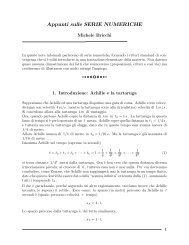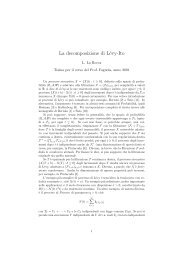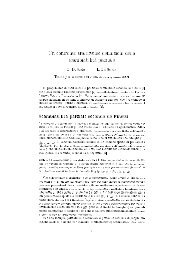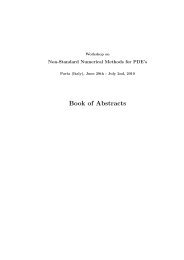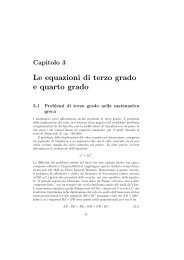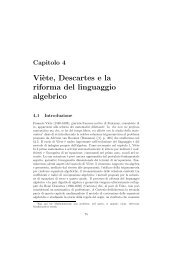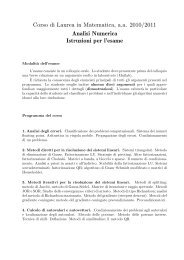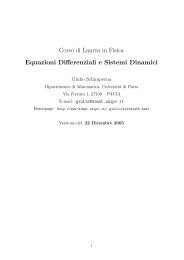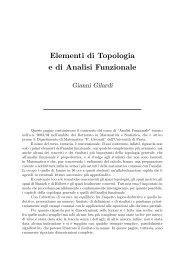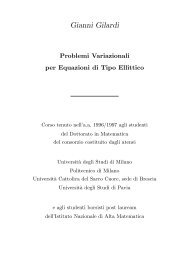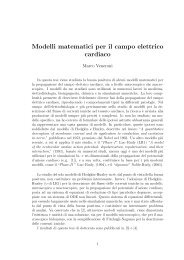G. Gilardi, Analisi Funzionale - Dipartimento di Matematica
G. Gilardi, Analisi Funzionale - Dipartimento di Matematica
G. Gilardi, Analisi Funzionale - Dipartimento di Matematica
You also want an ePaper? Increase the reach of your titles
YUMPU automatically turns print PDFs into web optimized ePapers that Google loves.
Il Teorema <strong>di</strong> Hahn-Banach<br />
è fissato, come nel caso già trattato otteniamo che D(∂g) = D(∂f) e che ∂g(x) = {Rx − z} per<br />
x ∈ D(f) . In particolare x ∈ H è punto <strong>di</strong> minimo per g se e solo se x ∈ R −1 (H) e Rx = z .<br />
Dunque, se cerchiamo il punto <strong>di</strong> minimo per la funzione g , come nell’esempio citato risolviamo<br />
l’equazione Rx = z , cioè ((x, y)) = 〈z, y〉 per ogni y ∈ V ove (( · , · )) è il prodotto scalare <strong>di</strong> V ,<br />
vale a <strong>di</strong>re ((x, y)) = (z, y) per ogni y ∈ V , ora con l’ipotesi aggiuntiva z ∈ H , trovando la<br />
soluzione x in R −1 (H) .<br />
Un esempio non banale <strong>di</strong> funzione convessa propria s.c.i. è descritto nel risultato che segue,<br />
nel quale si calcola anche il sotto<strong>di</strong>fferenziale. Si osservi preliminarmente che la composizione ϕ ◦ v<br />
<strong>di</strong> una funzione ϕ : R → (−∞, +∞] s.c.i. con una funzione v misurabile su uno spazio <strong>di</strong> misura<br />
è essa stessa misurabile. Come spesso si usa, scriviamo ϕ(v) anziché ϕ ◦ v .<br />
12.22. Proposizione. Siano ϕ : R → (−∞, +∞] una funzione convessa propria s.c.i.,<br />
(Ω, M, µ) uno spazio <strong>di</strong> misura finito e p ∈ (1, +∞) . Definiamo f : L p (Ω) → (−∞, +∞] me<strong>di</strong>ante<br />
�<br />
f(v) =<br />
Ω<br />
ϕ(v(x)) dµ se ϕ(v) ∈ L 1 (Ω) e f(v) = +∞ altrimenti. (12.11)<br />
Allora f è convessa propria s.c.i. e il suo sotto<strong>di</strong>fferenziale si ottiene come segue: se u ∈ Lp (Ω) e<br />
ξ ∈ Lp′ (Ω) risulta<br />
ξ ∈ ∂f(u) se e solo se ξ(x) ∈ ∂ϕ(u(x)) q.o. in Ω (12.12)<br />
con l’identificazione (Lp (Ω)) ∗ = Lp′ (Ω) tramite l’isomorfismo <strong>di</strong> Riesz.<br />
Dimostrazione. Osserviamo che effettivamente f non assume mai il valore −∞ . Infatti si scelga un<br />
polinomio P <strong>di</strong> grado ≤ 1 tale che P (t) ≤ ϕ(t) per ogni t ∈ R . L’esistenza <strong>di</strong> tale polinomio, senz’altro<br />
garantita dal Lemma 11.8 che deriva dal Teorema <strong>di</strong> Hahn-Banach, può essere in questo caso <strong>di</strong>mostrata<br />
in modo semplice e <strong>di</strong>retto come segue. Se D(ϕ) ha un solo punto t0 pren<strong>di</strong>amo P (t) = ϕ(t0) . In<br />
caso contrario D(ϕ) contiene un intervallo [a, b] non banale e, detto Q il polinomio <strong>di</strong> grado ≤ 1 che<br />
coincide con ϕ in a e in b e osservato che ϕ è continua in [a, b] , si può prendere P (t) = Q(t) − c ove<br />
c è il minimo <strong>di</strong> Q − ϕ in [a, b] . Trovato il polinomio P minorante, continuiamo il <strong>di</strong>scorso. Siccome<br />
P (v) ∈ L1 (Ω) per ogni v ∈ L1 (Ω) e Lp (Ω) ⊆ L1 (Ω) perché µ(Ω) < +∞ , abbiamo che f(v) > −∞ .<br />
Inoltre f è convessa e propria, come subito si verifica. Infine f è s.c.i., come ora controlliamo. Siano<br />
{un} una successione in Lp (Ω) convergente a u ∈ Lp (Ω) e λ = lim infn→∞ f(un) . Dobbiamo verificare<br />
che f(u) ≤ λ . Chiaramente possiamo supporre λ finito. Me<strong>di</strong>ante due estrazioni successive troviamo una<br />
sottosuccessione {unk } che verifica limk→∞ f(unk ) = λ e che converge a u q.o. Considerando ϕ − P se<br />
occorre, ci rinconduciamo al caso in cui ϕ è non negativa. Allora le funzioni ϕ(unk ) sono non negative e<br />
risulta 0 ≤ ϕ(u) ≤ lim infk→∞ ϕ(unk ) q.o. Per il Lemma <strong>di</strong> Fatou, deduciamo che ϕ(u) ∈ L1 (Ω) e che<br />
�<br />
�<br />
�<br />
f(u) = ϕ(u) dµ ≤ lim inf<br />
Ω<br />
Ω k→∞ ϕ(unk )� dµ<br />
�<br />
≤ lim inf ϕ(unk ) dµ = lim f(unk ) = λ .<br />
k→∞ Ω<br />
k→∞<br />
Veniamo alla (12.12). Supponiamo ξ ∈ ∂ϕ(u) q.o. Allora, per ogni v ∈ D(f) e per q.o. x ∈ Ω , risulta<br />
ϕ(u(x)) ≤ ξ(x) � u(x) − v(x) � + ϕ(v(x))<br />
e tutte le funzioni in gioco sono integrabili. Integrando si ottiene che ξ ∈ ∂f(u) .<br />
Supponiamo, viceversa, ξ ∈ ∂f(u) , cioè<br />
<strong>Analisi</strong> <strong>Funzionale</strong><br />
�<br />
Ω<br />
�<br />
�<br />
ξ (u − v) dµ + ϕ(v) dµ − ϕ(u) dµ ≥ 0 per ogni v ∈ D(f) .<br />
Ω<br />
Ω<br />
137



